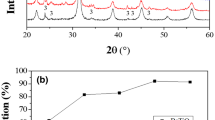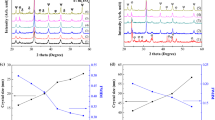Abstract
Microwave-assisted hydrothermal synthesis of nano-Nb doped BaTiO3 was performed at 150°C for 2 hours, using C16H36O4Ti, Ba(OH)2 · 8H2O, NbCl5 and NaOH as starting chemicals. The resulting powder deposited on to Al2O3 substrates with print screen method and were sintered by Microwave Sintering (MS) of 2.45 GHz at 950°C for 20 min and Conventional Sintering (CS) at 950°C for 90 min in the air atmosphere. It is observed that the grain growth can be suppressed by 2.45 GHz microwave heating process. The grains size distribution of sample sintered for 20 min with microwave heating process was rather uniform with lower grain size and higher surface area. Microstructure, surface morphology and grain size of the thick films were studied by Field-Emission Scanning Electron Microscopy (FE-SEM), Atomic Force Microscopy (AFM) and the surface area analysis with the Brunauer—Emmett—Teller (BET) method and the Barrett—Joyner—Halenda (BJH) method used for the pore size distribution.
Similar content being viewed by others
References
Hyun Tae Kim and Young Ho Han, Sintering of nanocrystalline BaTiO3, Ceram. Int., 2004, vol. 30, pp. 1719–1723.
Pornsuda Bomlai, Effects of surrounding powder in sintering process on the properties of Sb and Mn-doped barium strontium titanate PTCR ceramics, Songklanakarin, J. Sci. Technol., 2006, vol. 28, no. 3, pp. 669–675.
Han-Ill Yoo and Chang-Rock Song, Thermoelectricity of BaTiO3+δ, J. Electroceram., 2001, vol. 6, no. 1, pp. 61–74.
Yuan, Y., Zhang, S.R., Zhou, X.H., and Tang, B., Effects of Nb2O5 doping on the microstructure and the dielectric temperature characteristics of barium titanate ceramics, J. Mater. Sci., 2009, vol. 44, pp. 3751–3757.
Lifeng Liu, Haizhong Guo, Huibin Lu, Shouyu Dai, Bolin Cheng, and Zhenghao Chen, Effects of donor concentration on the electrical properties of Nb-doped BaTiO3 thin films, J. Appl. Phys., 2005, vol. 97, p. 054102.
Brzozowski, E., Castro, M.S., Foschini, C.R., and Stojanovic, B., Secondary phases in Nb-doped BaTiO3 Ceramics, Ceram. Int., 2002, vol. 28, pp. 773–777.
Shao, Y., Maunders, C., Rossouw, D., Kolodiazhnyi, T., and ABotton, G., Quantification of the Ti oxidation state in BaTi1-xNbxO3 compounds, Ultramicroscopy, 2010, vol. 110, pp. 1014–1019.
Hyun-Ji Noh and Sung-Gap Lee, Effect of sintering temperature on structural and dielectric properties of (Ba0.54Sr0.36Ca0.10)TiO3 thick films, Trans. Electr. Electron. Mater., 2009, vol. 10, no. 2, pp. 49–52.
Changlong Chen, Yuling Wei, Xiuling Jiao, and Dairong Chen, Hydrothermal synthesis of BaTiO3: Crystal phase and the Ba2+ ions leaching behavior in aqueous medium, Mater. Chem. Phys., 2008, vol. 110, pp. 186–191.
Sridhar Komarneni, Rustum Roy, and Li, Q.H., Micro-wave-hydrothermal synthesis of ceramic powders, Mater. Res. Bull., 1992, vol. 27, pp. 1393–1405.
Takamura, H., Enomoto, K., Aizumi, Y., Kamegawa, A., and Okada, M., Preparation and oxygen permeability of Pr—Al-based Perovskite-type oxides, Solid State Ionics, 2004, vol. 175, nos. 1–4, p. 379.
Weian Suna, Chuiha Li, Junqin Li, and Wen Liu, Microwave-hydrothermal synthesis of tetragonal BaTiO3 under various conditions, Mater. Chem. Phys., 2006, vol. 97, pp. 481–487.
Bharat L. Newalkar, Sridhar Komarneni, and Hiroaki Katsuki, Microwave-hydrothermal synthesis and characterization of barium titanate powders, Mater. Res. Bull., 2001, vol. 36, pp. 2347–2355.
Chao-Yu Lee, Michel Dupeuxb, and Wei-Hsing Tuan, Influence of firing temperature on interface adhesion between screen-printed Ag film and BaTiO3 substrate, Mater. Sci. Eng., Ser. A, 2007, vol. 467, pp. 125–131.
Dong-Hau Kuo, Chien-Chih Chang, Te-Yeu Su, WunKu Wang, and Bin-Yuan Lin, Dielectric behaviours of multi-doped BaTiO3/epoxy composites, J. Eur. Ceram. Soc., 2001, vol. 21, pp. 1171–1177.
Zhou Zhen-Jun, Yang Zheng-Fang, and Qi-Ming, Barium titanate ceramic inks for continuous ink-jet printing synthesized by mechanical mixing Yuan and sol—gel methods, T Nonferr. Metal. Soc., 2008, vol. 18, pp. 150–154.
Kyung-Woon Jang and Kyung-Wook Paik, Screen printable epoxy/BaTiO3 embedded capacitor pastes with high dielectric constant for organic substrate applications, J. Appl. Polym. Sci., 2008, vol. 110, pp. 798–807.
Yuan, Y., Zhang, S.R., Zhou, X.H., and Tang, B., Effects of Nb2O5 doping on the microstructure and the dielectric temperature characteristics of barium titanate ceramics, J. Mater. Sci., 2009, vol. 44, pp. 3751–3757.
Weian Sun, Chuiha Li, Junqin Li, and Wen Liu, Microwave-hydrothermal synthesis of tetragonal BaTiO3 under various conditions, Mat. Chem. Phys., 2006, vol. 97, pp. 481–487.
Sung Hwa Jhung, Jin-Ho Lee, Ji Woong Yoon, Young Kyu Hwang, Jin-Soo Hwang, Sang-Eon Park, and Jong-San Chang, Effects of reaction conditions in microwave synthesis of nanocrystalline barium titanate, Mater. Lett., 2004, vol. 58, pp. 3161–3165.
Yuji Hotta, Kiyoka Tsunekawa, Cihangir Duran, Kimiysu Sato, Takaaki Nagaoka, and Koji Watari, Low-temperature sintering of BaTiO3 powders prepared by a hydrothermal process with ball milling system, Mater. Sci. Eng., Ser. A, 2008, vol. 475, pp. 57–61.
Yuji Hotta, Kiyoka Tsunekawa, Toshihiro Isobe, Kimiysu Sato, and Koji Watari, Synthesis of BaTiO3 powders by a ball milling-assisted hydrothermal reaction, Mater. Sci. Eng., Ser. A, 2008, vol. 475, pp. 12–16.
Siminiceanu, I., Lazau, I., Ecsedi, Z., Lupa, L., and Burciag, C., Textural characterization of a new ironbased ammonia synthesis catalyst, Chem. Bull. “Politehnica” Univ. Timisoara, ROMANIA, Ser. Chem. Environ. Eng., 2008, vol. 53, nos. 1–2, pp. 38–44.
International union of pure and applied chemistry physical chemistry division commission on colloid and surface chemistry, subcommittee on characterization of porous solids: Recommendations for the characterization of porous solids, Technical Report, Pure Appl. Chem., 1994, vol. 66, no. 8, pp. 1739–1758.
Dang-Hyok Yoon and Burtrand I. Lee, Processing of barium titanate tapes with different binders for MLCC applications, Part I: Optimization using design of experiments, J. Eur. Ceram. Soc., 2004, vol. 24, pp. 739–752.
Janssen, A.H., Koster, A.J., and de Jong, K.P., On the shape of the mesopores in zeolite Y: a three-dimensional transmission electron microscopy study combined with texture analysis, J. Phys. Chem., Ser. B, 2002, vol. 106, pp. 11905–11909.
Author information
Authors and Affiliations
Corresponding author
Additional information
The article is published in the original.
About this article
Cite this article
Khanfekr, A., Naghizadeh, R. & Tamizifar, M. Microwave and conventional sintering and grain growth behavior of nano-Nb doped BaTiO3 prepared from microwave hydrothermal powders. Surf. Engin. Appl.Electrochem. 51, 305–312 (2015). https://doi.org/10.3103/S1068375515040080
Received:
Accepted:
Published:
Issue Date:
DOI: https://doi.org/10.3103/S1068375515040080




